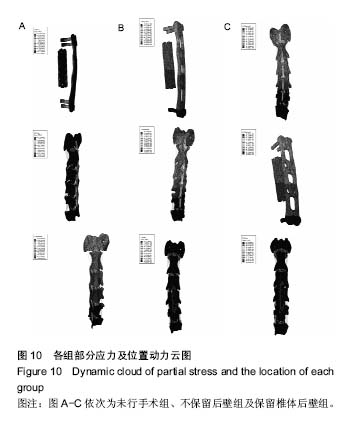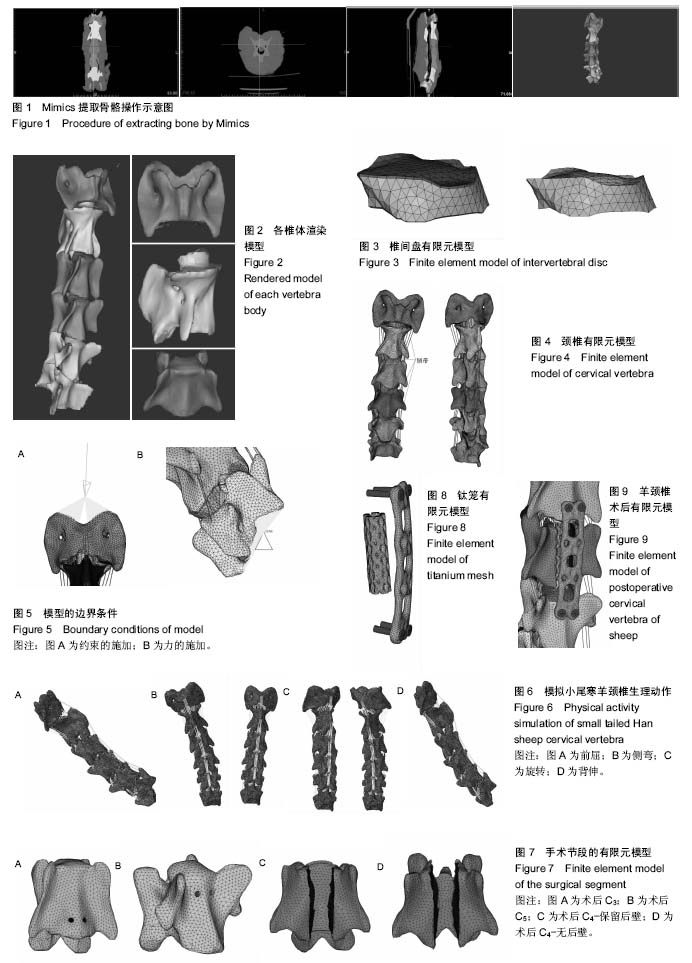| [1] 刘长安,张卫平,王凌云,等.颈椎前路多节段椎体次全切减压植骨融合内固定术治疗多节段脊髓型颈椎病[J]. 解放军医药杂志, 2015,27(4):24-27.[2] 吴畏,朱天亮.前路椎间盘切除减压融合与椎体次全切除减压融合治疗多节段颈椎病疗效比较[J].临床骨科杂志, 2014,17(5): 497-500.[3] 许良,孔鹏, 徐展望.颈前路椎体次全切减压钛网植骨融合联合钛板固定治疗多节段脊髓型颈椎病[J].中国骨伤, 2016, 29(3): 211-215.[4] 黄超,李光富.颈椎前路多节段椎体次全切减压植骨融合内固定术治疗多节段脊髓型颈椎病[J]. 医药前沿, 2016, 6(14): 143-144.[5] Liu X, Min S, Zhang H, et al. Anterior corpectomy versus posterior laminoplasty for multilevel cervical myelopathy: a systematic review and meta-analysis. Eur Spine J.2014;23(2):362-372.[6] Saunders RL, Bernini PM, Shirreffs TG Jr, et al. Central corpectomy for cervical spondylotic myelopathy: A conservative series with long-term follow-up evaluation. J Neurosurg. 1991;74:163-170.[7] Zafarparandeh I, Erbulut DU, Lazoglu I, et al. Development of a finite element model of the human cervical spine. Turkish Neurosurg.2014;24(3):312-318.[8] De Vries Watson NA, Gandhi AA, Fredericks DC, et al. Sheep cervical spine biomechanics: a finite element study. Iowa Orthop J. 2014;34(34):137-143.[9] 郭磊,蔡璇,秦杰,等.下颈椎三维有限元模型的建立与验证[C]// 全国脊柱脊髓损伤治疗与康复技术研讨会暨2014年海南省医学会骨科学术年会. 2014.[10] 周毅强,张建新,林蔚莘.全颈椎三维有限元模型的建立[J].中医临床研究, 2014,6(25):137-140.[11] 黄祖和,徐志宾,闫剑锋,等. 64排螺旋CT精细扫描全颈椎三维有限元模型的建立及验证[J].深圳中西医结合杂志, 2016, 26(11): 33-34.[12] Wada E,Suzuki S,Kanazawa A,et al.Subtotal corpectomy versus laminoplasty for multilevel cervical spondylotic myelopathy: a long-term follow-up study over 10 years. Spine. 2001;26(13):1443-1447.[13] Niu CC,Hai Y, Fredrickson BE,et al.Anterior cervical corpectomy and strut graft fusion using a different method. Spine J. 2002;2(3):179-187.[14] Hackel M,Stejskal L,Kramar F,et al.Anterior cervical corpectomy in the treatment of multilevel degenerative stenoses with spondylotic myelopathy:Personal experience with therapy and a literature review. Rozhl Chir. 2001;80(4): 163-169. [15] Epstein N.Anterior approaches to cervical spondylosis and ossification of the posterior longitudinal ligament: review of operative technique and assessment of 65 multilevel circumferential procedures. Surg Neurol. 2001;55(6): 313-324. [16] Fessler RG, Steck JC, Giovanini MA.Anterior cervical corpectomy for cervical spondylotic myelopathy. Neurosurgery. 1998;43(2): 257-265.[17] Jamjoon A,Williams C,Cummins B.The treatment of spondylotic cervical spine myelopathy by multiple subtotal vertebrectomy and fusion.Br J Neurosurg. 1991;5:249-255.[18] 邹德威,谭荣,马华松,等.颈椎前路减压植骨融合不同术式长期随访结果比较[J].中国脊柱脊髓杂志, 2005,15(2):69-72.[19] 张俊杰.保留椎体后壁的颈椎椎体次全切除减压术的生物力学研究[D].第二军医大学, 2005.[20] Caspar W,Barbier DD,Klara PM. Anterior cervical fusion and caspar plate stabilization for cervical trauma. Neurosurgery. 1989;25:491-502.[21] 袁文.前路椎体次全切除减压及带锁钢板固定治疗脊髓型颈椎病[J].中华外科杂志,2000,38(3):182-184.[22] Banerji D,Acharya R,Behari S,et al.Corpectomy for multi-level cervical spondylosis and ossification of the posterior longitudinal ligament. Neurosurg Rev. 1997;20(1): 25-31.[23] 倪斌,贾连顺,朱海波,等.颈椎后纵韧带骨化症的前路手术治疗[J].第二军医大学学报,1997,18(6):510-512.[24] 薄雪峰,陈赞,王辉,等.颈椎三维有限元模型的建立[J].北京生物医学工程, 2014, 33(5):452-455.[25] 王甲甲.人体颈椎有限元建模及仿生颈椎椎间融合器研究[D]. 吉林大学, 2014.[26] 杨加, 吴祈耀,田捷,等.几种图像分割算法在 CT 图像分割上的实现和比较[J].北京理工大学学报, 2000, 20(6): 720-723.[27] 李久权, 王平, 王永强. CT 图像分割几种算法[J]. 微计算机信息(测控自动化), 2006, 22(2-1): 240-242.[28] 钱志辉.人体足部运动的有限元建模及其生物力学功能耦合分析[D]. 吉林大学, 2010.[29] Zhang QH, Teo EC, Ng HW, et al. Finite element analysis of moment-rotation relationships for human cervical spine. J Biomech. 2006;39(1):189-193.[30] Ha SK. Finite element modeling of multi-level cervical spinal segments (C3-C6) and biomechanical analysis of an elastomer-type prosthetic disc. Med Eng Phys. 2006;28(6): 534-541.[31] 王辉昊,詹红生,陈博,等.正常人全颈椎(C0-T1)三维有限元模型的建立与验证[J].生物医学工程学杂志,2014,31(6):1238-1242.[32] 关哲,马迅,梁凯恒,等.上颈椎有限元模型的建立及寰椎生物力学有限元分析[J]. 中国脊柱脊髓杂志, 2009, 19(7):530-534.[33] 杨阶鑫, 胡优威, 谭益云,等. 颈椎次全切除钛网植骨AO带锁钢板内固定治疗脊髓型颈椎病[J]. 家庭心理医生, 2015,1:152.[34] 黄卫,李新志,卢国强,等.颈椎次全切除+钛网植骨内固定术治疗多节段脊髓型颈椎病的临床疗效研究[J]. 医药前沿, 2014,4(24): 196-197.[35] 许良,孔鹏,徐展望.颈前路椎体次全切减压钛网植骨融合联合钛板固定治疗多节段脊髓型颈椎病[J].中国骨伤, 2016, 29(3): 211-215.[36] Hey HW, Wong KL, Long AS, et al. Single-level Anterior Corpectomy with Fusion versus 2-level Anterior Cervical Decompression with Fusion: A Prospective Controlled Study with 2-year Follow-up Using Cages for Fusion. Ann Acad Med. 2015;45(5):188-190.[37] Kim S, Lee SH, Kim ES, et al. Clinical and radiographic analysis of c5 palsy after anterior cervical decompression and fusion for cervical degenerative disease. J Spinal Disord Tech. 2014;27(8):436-441.[38] Belanger TA, Roh JS, Hanks SE, et al. Ossification of the posterior longitudinal ligament. Results of anterior cervical decompression and arthrodesis in sixty-one North American patients. J Bone Joint Surg Am. 2005;35(3):528-529. |
.jpg)


.jpg)
.jpg)
.jpg)

.jpg)